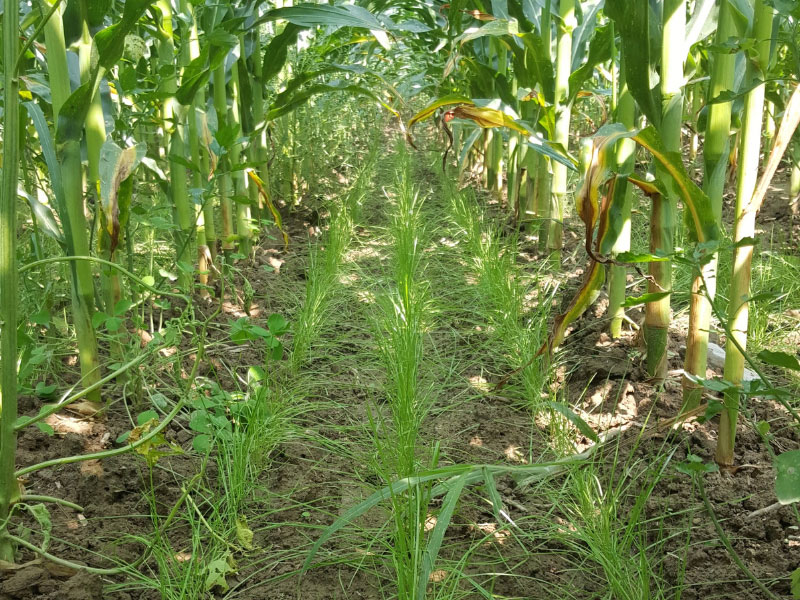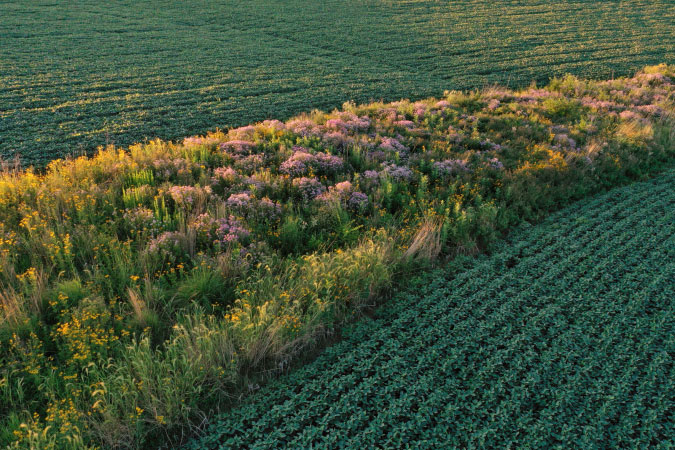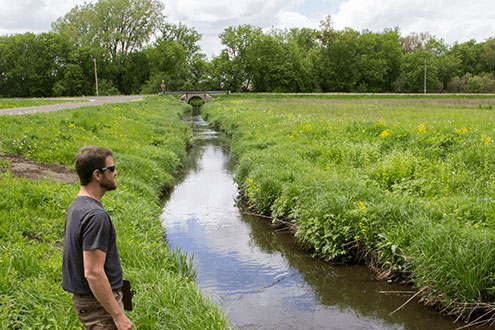Interseeded annual ryegrass cover crop established under a corn canopy. Credit: Sarah Isbell. Enlarge image.
Prairie strip in the middle of a field. Credit: Iowa State University. Enlarge image.
Conservation specialist looking over a buffer strip. Credit: Wisconsin Land & Water Conservation Association. Enlarge image.
What Are BMPs?
Implementing best management practices (BMPs) is crucial for reducing phosphorus runoff from farms. BMPs are strategies tailored to specific agricultural settings that help keep soil and nutrients on the land and reduce phosphorus entering waterways. By combining these practices, stakeholders can effectively tackle phosphorus runoff issues in the Western Lake Erie Basin. Improving soil health, reducing erosion, and managing nutrients well can significantly lower phosphorus loading and protect watershed health.
BMP Examples
- Crop Rotation: Enhances yields, improves nutrient uptake, and manages pests and diseases.
- Perennial Forages: Adding crops like hay reduces nutrient loss and erosion.
- Reduced Tillage: Methods such as no-till and strip-till decrease soil erosion and increase water absorption. Pairing conservation tillage with practices like reducing soil test phosphorus (STP) and subsurface fertilizer application can address surface phosphorus issues.
- Cover Crops: Help reduce soil erosion and retain nutrients but should be combined with other practices to manage dissolved reactive phosphorus (DRP) losses.
- Nutrient Management: Applying phosphorus based on STP recommendations and using the 4R Nutrient Management approach (right source, right time, right rate, right place) enhances crop uptake and reduces nutrient losses.
- Filter or Buffer Strips: Reduce water contamination and soil erosion by providing a barrier between farmland and waterways.
- Wetlands: Improve water quality by absorbing nutrients from runoff and benefit wildlife.
- Prairie Strips: Integrate native perennial vegetation to capture runoff and reduce nutrient loss.
- Water and Sediment Control Basins: Prevent downstream sediment movement and manage runoff to improve water quality.
- Controlled Drainage Systems: Allows farmer to apply fertilizer at different rates in different locations within fields.
- Variable rate technology: Manage water levels in fields to reduce nutrient loss and soil erosion.
Applying less phosphorus based on variable rate application of fertilizer to just the parts of the field that need it while planting cover crops can improve water quality in subsurface drainage. The 4R Nutrient Management approach—right source, right time, right rate, right place—helps reduce nutrient losses and enhance crop uptake of nutrients before they are lost to the surrounding environment.
On the edge of fields, filter or buffer strips, wetlands, and prairie strips all help reduce water contamination and erosion, while water and sediment control basins and controlled drainage systems manage runoff and improve water quality downstream.
The most effective way to improve water quality is to use a combination of BMPs suited to the specific needs of the land.
Funding Opportunities
Implementing BMPs can contribute significantly to the public good and are worth the investment. Luckily, public funding to help you implement BMPs on your land is available. A good place to start looking for funding is your local Natural Resources Conservation Service office. You can locate your nearest service center here.
Resources:
- SARE: Building Soils for Better Crops - Ch 11. Diversifying Cropping Systems
- With or without erosion, phosphorus losses occur
- Cover Crops at Work: Covering the Soil to Prevent Erosion
- The 4Rs of Nutrient Stewardship
- Filter Strips Vs. Buffer Strips
- Wetlands and Water Quality
- What are Prairie Strips?
- Water and Sediment Basin (NRCS 350 & 638)
- Controlled drainage: Conserving nutrients and improving bottom lines
- Stacked practices: The key to phosphorus loss reduction


